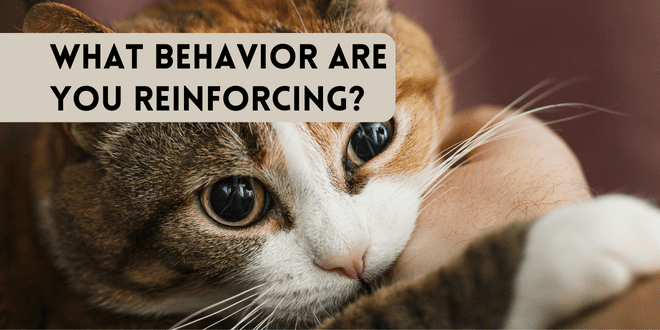
Sometimes the reason a cat continues to display unwanted behavior is because we unknowingly actually reinforce it. Of course, we’re not doing it deliberately but the bottom line is the cat receives a message that says keep doing what you’re doing. These mistakes we make are actually very common and even the most experienced cat parent slips up when it comes to sending consistent messages.
The Messages You Send
Think about when you’ve offered your cat a treat, a meal or even some attention to quiet her down due to her relentless vocalizations. You’re working at the kitchen counter or sitting at the computer and your cat meows and meows for attention. You pet your kitty as she meows or maybe you even pick her up, put her on your lap or cuddle her. What’s the message the cat just received? Relentless meowing results in a reward. Even just shouting at her to be quiet gives her some form of attention for the behavior.
You’re asleep in bed and your cat meows and walks back and forth across your chest in the wee hours of the morning. Do you pet to quiet her down? Talk to your kitty? Or, maybe you just get up and put some food in her food bowl so she’ll let you get a few more hours of sleep. Again, the message received by the cat is that the behavior displayed results in a reward.
It’s important not to send mixed messages. Instead of giving attention to the cat for unwanted behavior, reward for displaying desired behavior. If your cat meows constantly, reward her with a treat, praise, play or petting when she’s quiet. Even if the quiet behavior lasts a very short time, you need to switch your training method to catch the behavior you DO want and reward that. Once you start doing this you can increase the amount of time (in small increments) your cat needs to be quiet before a reward is offered. This sends a clear message to your cat that being quiet is the behavior that will result in something good and meowing will result in nothing at all. Your cat is very smart so it won’t take long for her to realize the behavior that has a more beneficial pay-off.
Help Your Cat Succeed
The other part of rewarding positive behavior is to set your cat up to succeed. If the cat meows at you when you head to the kitchen to work on dinner or sit down to work on the computer, maybe she’s not getting enough environmental enrichment and interactive playtime. Before you start a task, engage her in a quick play session or set out a fun food-dispensing toy or other puzzle-type toy. This way, you provide her with beneficial activity and attention so the unwanted behavior never has to come into play at all.
If your cat meows in the wee hours of the morning because she wants food, set out some puzzle feeders during the night or use an automatic timed feeding bowl. You can also reset her internal kitty clock by conducting an interactive play session right before bedtime. Use a fishing pole toy and conduct a fun play session where your cat gets to stalk, pounce and capture “prey” multiple times. Wind down the action at the end of the game to leave your cat more relaxed and satisfied. Offer a portion of the normal meal (divide up their daily amount so you aren’t increasing the normal amount) as a reward for her exceptional hunting skills. With food in her tummy and feeling relaxed after having had a play session, she’ll be more likely to sleep through the night.
Another example of sending the wrong message is when a cat jumps on the kitchen counter and the person shoos her off by picking her up, cuddling, maybe even planting a kiss on the top of the head and then placing kitty back down on the floor. The message kitty receives is that jumping on the counter gets the attention she wants. The proper technique to use is to set up the counter to be unappealing by using plastic carpet protectors (feet side up). If your cat jumps up anyway or the counter isn’t covered, merely pick the cat up without engaging in eye contact and casually place her on the floor. Offer your cat a better alternative for an elevation location as well. Set up a cat tree or window perch so she has a high location to hang out that meets with your approval. Reward your cat with attention, treat or praise whenever she goes to the desired location instead of the counter.
The above are just examples of how we often send the wrong message when trying to train our cats. It’s time to examine how you interact with your cat and whether you’ve been guilty of sending conflicting signals. Remember:
- Reward positive behavior
- Don’t send mixed messages
- Set your cat up to succeed
Need More Information?
If you’re having a behavior problem with your cat, consult your veterinarian to make sure there isn’t an underlying medical problem. If your cat gets a clean bill of health, your veterinarian may refer you to veterinary behaviorist or certified cat behavior consultant.
For more information on cat behavior and training, refer to the books by Pam Johnson-Bennett. Pam’s books are available at bookstores and online. We’ve included links to Amazon on our website.
If you have a question about your cat’s behavior or health, contact your veterinarian. This article is not intended as a medical diagnosis nor is it a replacement for your cat’s regular veterinary care. This article is for general information purposes only.




